Punjab State Board PSEB 10th Class Maths Book Solutions Chapter 13 Surface Areas and Volumes Ex 13.4 Textbook Exercise Questions and Answers.
PSEB Solutions for Class 10 Maths Chapter 13 Surface Areas and Volumes Ex 13.4
Question 1.
A drinking glass is in the shape of a frustum of a cone of height 14 cm. The diameters of its two circular ends are 4 cm and 2 cm. Find the capacity of the glass.
Solution:
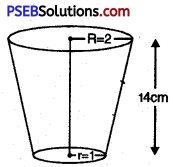
Radius of upper end (R) = 2 cm
Radius of lower end (r) = 1 cm
Height of glass (H) = 14 cm
Glass is in the shape of frustum
Volume of frustum = \(\frac{1}{3}\) π [R2 + r2 +Rr]H
= \(\frac{1}{3}\) × \(\frac{22}{7}\) [(2)2 + (1)2 + 2 × 1] 14
= \(\frac{1}{3}\) × \(\frac{22}{7}\) [4 + 1 + 2] 14
= \(\frac{1}{3}\) × \(\frac{22}{7}\) × 7 × 14
= \(\frac{22 \times 14}{3}\)
Hence, Volume of glass = 102.67 cm3.
![]()
Question 2.
The slant height of a frustum of a cone is 4 cm and the perimeters (circumference) of its circular ends are 18 cm and 6 cm. Find the curved surface area of the frustum.
Solution:
Slant height of frustum = 4 cm
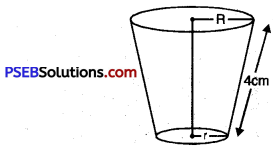
Let radius of upper end and lower ends are R and r
Circumference of upper end = 18 cm
2πR = 18
R = \(\frac{18}{2 \pi}=\frac{9}{\pi}\) cm
Circumference of lower end = 6 cm
2πr = 6 cm
r = \(\frac{6}{2 \pi}=\frac{3}{\pi}\) cm
Curved surface area of frustum = π [R + r] l
= π \(\left[\frac{9}{\pi}+\frac{3}{\pi}\right]\) 4
= π \(\left[\frac{9+3}{\pi}\right]\) 4
= 12 × 4 = 48 cm2
Hence, Curved surface area of frustum = 48 cm2.
![]()
Question 3.
A fez, the cap used by the Turks, is shaded like the frustum of a cone. If its radius on the open side is 10 cm, radius at the upper base is 4 cm and its slant height is 15 cm, find the area of material used for making it.
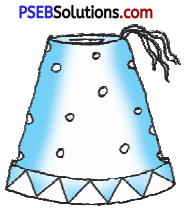
Solution:
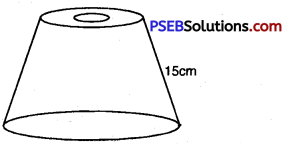
Radius of lower end of frustum (R) = 10 cm
Radius of upper end of frustum (r) = 4 cm
Slant height of frustum (l) = 15 cm
Curved surface area of frustum = πL [R+ r]
= \(\frac{22}{7}\) × 15 [10 + 4]
= \(\frac{22}{7}\) × 15 × 14
= 22 × 15 × 2 = 660 cm2
Area of the closed side = πr2 = \(\frac{22}{7}\) × (4)2
= \(\frac{22}{7}\) × 4 × 4 = \(\frac{352}{7}\) cm2
Total area of the material used = Curved surface area of frustum + Area of the closed side
= 660 + 50.28 = 710.28 cm2
Hence, Total material used = 710.28 cm2.
Question 4.
A container opened from the top is made up of a metal sheet ¡s in the form of a frustum of a cone of height 16 cm with radii of its lower and upper ends as 8 cm and 20 cm, respectively. Find the cost of the milk which can completely fill the container, at the rate, of ₹ 20 per litre. Also fmd the cost of metal sheet used to make the container, If it costs ₹ 8 per 100 cm2. (Take π = 3:14.)
Solution:
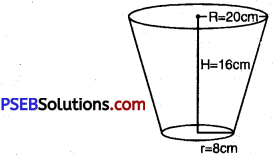
Radius of upper end of container (R) = 20 cm
Radius of lower end of container (r) = 8 cm
Height of container (H) = 16 cm
Slant height (l) = \(\sqrt{\mathrm{H}^{2}+(\mathrm{R}-r)^{2}}\)
= \(\sqrt{(16)^{2}+(20-8)^{2}}\) = \(\sqrt{256+144}\)
Slant height (l) = \(\sqrt{400}=\sqrt{20 \times 20}\) = 20 cm
Capacity of the container = \(\frac{1}{3}\) πH[R2 + r2 + Rr]
= \(\frac{1}{3}\) × 3.14 × 16 [(20)2 + (8)2 + 20 × 8]
= \(\frac{3.14 \times 16}{3}\) [400 + 64 + 100]
= 3.14 × 16 × 624 = 10449.92 cm3
Milk in the container = 10449.92 cm3
= \(\frac{10449.92}{1000}\) litres [∵ 1 cm3 = \(\frac{1}{1000}\) litres]
∴ Milk in the container = 10.45 litres
Cost of 1 it. milk = ₹ 20
∴ Cost of 10.45 litre = ₹ 20 × 10.45
Total cost of milk = ₹ 209
Curved surface area of frustum = πL [R + r]
= 3.14 × 20[20 + 8]
= 3.14 × 20 × 28 cm2 = 1758.4 cm2
Area of base of container = πr2
= 3.14 × (8)π = 3.14 × 64 = 200.96 cm2
Total metal used to make coniainer = curved surface area of frustum + area of base
= (1758. 4 + 200.96) cm2 = 1959.36 cm2
Cost of 100 cm2 metal sheet used = ₹ 8
Cost of 1 cm2 metal sheet used = ₹ \(\frac{8}{100}\)
Cost of 1959.36 cm2 metal sheet used = ₹ \(\frac{8}{100}\) × 1959.36
= ₹ 156.748 = ₹ 156.75
Hence, Total cost of sheet used = ₹ 156.75
and Total cost of milk is ₹ 209.
Question 5.
A metallic right circular cone 20 cm high and whose vertical angle Ls 600 is cut into two parts at the middle of its height by a plane parallel to Its base. If the frustum so obtained be drawn into a wire of diameter \(\frac{4}{4}\) cm, find the length of the wire.
Solution:
Vertical angle of cone = 60°
Altitude of cone divide vertical angle ∠EOF = 30°
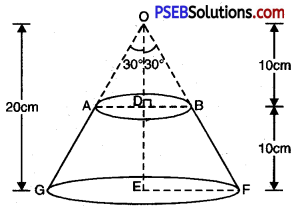
In ∆ODB,
\(\frac{\mathrm{BD}}{\mathrm{OD}}\) = tan 30°
r = \(\frac{10}{\sqrt{3}}\) cm
In ∆OEF,
\(\frac{E F}{O E}\) = tan 30°
\(\frac{\mathrm{R}}{20}=\frac{1}{\sqrt{3}}\)R = \(\frac{20}{\sqrt{3}}\) cm
Volume of frustum = \(\frac{\pi}{3}\)h[R2 + r2 + Rr]
= \(\frac{22}{73} \times \frac{10}{3}\left[\left(\frac{20}{\sqrt{3}}\right)^{2}+\left(\frac{10}{\sqrt{3}}\right)^{2}+\frac{20}{\sqrt{3}} \times \frac{10}{\sqrt{3}}\right]\)
= \(\frac{22}{7} \times \frac{10}{3}\left[\frac{400}{3}+\frac{100}{3}+\frac{200}{3}\right]\)
= \(\frac{22}{7} \times \frac{10}{3}\left[\frac{400+100+200}{3}\right]\)
Volume of frustum = \(\frac{22}{7} \times 10 \times \frac{700}{9}\) cm3
= \(\frac{22}{7} \times \frac{7000}{9}\) cm3
Frustum is made into wiie, which is in shape of cylinder having diameter \(\frac{1}{16}\) cm
∴ Radius of cylinderical wire (r1) = \(\frac{1}{2} \times \frac{1}{16} \mathrm{~cm}=\frac{1}{32} \mathrm{~cm}\)
Let height of cylinder so formed be H cm
On recasting volume remain same
Volume of frustum = Volume of cylindrical wire
\(\frac{22}{7} \times \frac{7000}{9}\) = πr12H
\(\frac{22}{7} \times \frac{7000}{9}=\frac{22}{7} \times\left(\frac{1}{32}\right)^{2} \times \mathrm{H}\)H = \(\frac{\frac{22}{7} \times \frac{7000}{9}}{\frac{22}{7} \times \frac{1}{32} \times \frac{1}{32}}\)
= \(\frac{7000}{9}\) × 32 × 32
H = 796444.44 cm
H = \(\) = 7964.44 m
Hence, Length of cylindrical wire (H) = 7964.44 m
